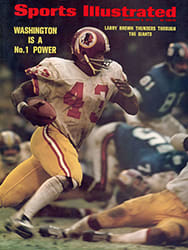
One more for the grinder
The Little Brown Jug, a modest crockery vessel now 69 years of age, was once a trophy for titans. It was fought for on the battlefield of national championships and much of college football's history is written on its sides. Ah, but no more, no more. One night last week, just before the annual Michigan-Minnesota "classic rivalry," as it used to be called, Glenn E. (Bo) Schembechler, a sandy-haired efficiency expert who coaches Michigan, found it expedient to call a meeting of his team and gently explain all about the Little Brown Jug, that it went to the winner of this game. "Some of our younger fellows didn't know all that much about it," he said later. "It's not something that we dwell on a lot."
That is not hard to understand. The Wolverines are a powerful crowd, unbeaten and ranked fifth in the country last week, and they were rated 29-point favorites over the enfeebled Gophers, who had won just one game. Of course, 29 points is a grotesque and insulting spread. Bo Schembechler said scornfully, "There is no way two Big Ten teams should ever be rated that far apart."
Well, neither the Big Ten nor the Little Brown Jug are quite what they used to be. And on a chill, foggy afternoon before 84,190 moist fans in Michigan Stadium, the Wolverines absolutely eradicated the Gophers 42-0. One shudders at the ease with which the execution was done (although one could not be surprised, for it was the fifth straight win in the series for Michigan, which has scored 184 points in those five games). The Wolverines chewed up the Gophers with their usual brutish combination of a nearly flawless defense and a hard-slogging, mind-numbing ground game. The defense, a quick and aggressive bunch, was particularly impressive against Minnesota, smothering what little spark the Gophers may have had by recovering one fumble and intercepting four passes, one resulting in a 68-yard touchdown return by Safety Dave Brown, who also intercepted another pass and was in on no less than 13 tackles. Schembechler kept most of his first-string defense in the game until the fourth quarter despite the desperately lopsided score because he wanted to be sure Minnesota got no points: the Wolverines lead the nation in anti-scoring, having held their seven opponents to an average of 4.2 points per game.
As for the Michigan offense, it has long been labeled colorless and odorless, an excruciatingly repetitious exercise in butchery and boredom. It has been called the Meat Grinder's Offense. Bo Schembechler takes umbrage at the label: "Well," he said, "it is true that I told some reporters that if we have to grind meat to move the ball, then we'll grind meat. And I meant just that. Last year we could not pass well and we had to do the meat-grinding thing. This year we're more versatile."
Until last week it didn't really seem so. The Wolverines had spent so much time making hamburger that before the Minnesota game they had rushed for 1,802 yards while passing for a mere 321. And against the Gophers, the Wolverine running attack was still the major weapon of the day. Operating out of the Power I, Michigan's backs moved with ease through Minnesota's mushy and uncertain defense. Fullback Ed Shuttlesworth, a relentless runner, thudded into the line again and again, chopping off what seemed like dozens of steady, unspectacular five-yard gains. In all, Shuttlesworth carried 19 times for 86 yards and scored on four touchdown runs, the longest from four yards out. Although it hardly seemed to exert itself against the Gophers, Michigan had gained 245 yards on the ground when the dank afternoon was over. Though several other Wolverine ballcarriers have been most impressive in previous games this year—notably the quick little sophomore split end, Gil Chapman, who has scored touchdowns on runs of 58 and 73 yards, and Tailback Chuck Heater, another sophomore, who is averaging over five yards per carry—none shone with particular brightness against Minnesota's somber defense.
None, that is, with the impressive exception of the Wolverine quarterback, a cool and lanky black sophomore from Massillon, Ohio named Dennis Franklin. His performance was extraordinary, perhaps more for what it forecast about him and about Michigan than for what he actually accomplished against Minnesota. He won the starting job when his competition, Kevin Casey, was hurt just before the season began. "The Menace has been developing beyond anything we could have hoped," says Schembechler. "He's getting smoother and better and smarter every day." Prior to the Minnesota game, Franklin's forte had been his handling of the Power I (he is an exceptional faker) and his own running from various options (he had gained 347 yards in 71 carries). However, his passing had been mediocre and every bit as infrequent as one would expect from the man running a meat-grinding machine.
This is not to say that Dennis Franklin burst upon the world last Saturday as a budding Namath. Against Minnesota his running was still his strength and he gained 74 yards in nine rushes and scored a touchdown. He also led the team with confidence and authority which belie his years. Though Schembechler calls basic plays from the bench and his teams have been labeled "Bo's Robots," he claims that Franklin changes plays consistently through audible calls at the line of scrimmage. But beyond these expected things, Dennis Franklin also threw eight passes, completing five for 94 yards. Hardly eye-popping statistics by some standards, but those who have come to know Michigan football appreciated the performance. Franklin threw with powerful zip and fine accuracy, smacking his receivers square in the numbers. One cannot remake a Meat Grinder into a Phantom Jet in one day, but Michigan is trying to diversify.
All of which should make the Wolverines one of the most formidable teams in the country, right? Well, not necessarily. It is a little hard to tell how good the team really is. It has been widely (and rightly) accused of having one of the nation's most marshmallowy schedules, a coach's candy dream list that includes only UCLA, Ohio State and, to be generous, Purdue, as authentic football teams out of the 11 that Michigan meets. So far, the Wolverines have simply ravaged their opposition, scoring 192 points to 30 and gaining nearly twice as many yards. And who have they beaten? Here is who: Northwestern, UCLA, Tulane, Navy, Michigan State, Illinois and Minnesota. Only one—UCLA—has a winning percentage.
Now it is true that Michigan was enormously impressive in defeating a fine UCLA team 26-9, even though UCLA played most of the game without its No. 1 quarterback, Mark Harmon. That win was no fluke. "I'm not boasting that this is some kind of a superteam," says Schembechler, "but this schedule was made up years ago and it was not arranged to make it easy. My God, it's got eight Big Ten teams on it. Don't forget, whatever they're saying about the Big Ten nowadays, it's still a very physical league and there are plenty of damn good football players in it."
Perhaps so. But they are saying some very insulting things about the Big Ten nowadays. There was a time, about 17 or 18 years ago, when the Little Brown Jug did not have to be explained to Michigan football players no matter how young they were, and when any team playing eight Big Ten teams would have been facing one of the fiercest tests of courage known to organized sport. Any team that emerged from that brutal caldron unbeaten would be crowned national champion practically by unanimous consent. Now the weekly football rankings list once-beaten Nebraska higher than either of the two undefeated Big Ten teams—Michigan and Ohio State. Among the reasons for this loss of prestige is the fact that for three straight years the Big Ten has sent its champion to the Rose Bowl and has emerged with a loser each time. Thus a Big Ten schedule is regarded as little more than a sweet autumn waltz. Don Canham, Michigan's energetic and outspoken athletic director, said, "We all assumed the Big Ten would be the Big Ten forever. We didn't change with the times. Complacency killed the king. We weren't generous enough with our scholarships. We refused to put in a redshirt eligibility rule. We wouldn't let our conference champions go to the Rose Bowl in consecutive years. We've probably done less construction of new athletic facilities in the Big Ten than any other conference in the country. And every other league around came into our territory and recruited our kids. We did not—we could not—compete. We can turn it around and we will. But we'll never be the Big Ten we were."
Certainly not. Today the Big Ten probably ranks a sliding fourth in college football conferences—behind the Big Eight, Pacific Eight and Southeastern. Whatever the Big Ten may come to be, it is today a has-been.
How good is Michigan? It isn't likely anyone will know for sure until Nov. 25, when the Wolverines clash at last with the Buckeyes of Ohio State. They were among a mere five unbeaten teams in the U.S. last week. And unless the sky snows stones or the sun turns black, both will remain undefeated until they meet on the last day of their seasons. For Ohio State has an even easier schedule than Michigan, playing eight Big Ten friends plus North Carolina (5-1) of the relatively lower-echelon Atlantic Coast Conference and beleaguered California (1-7).
The trophy in the Michigan-Ohio State battle will be, of course, tickets to the Rose Bowl, where it is just possible that the national championship may also hang in the balance, assuming an unbeaten USC is the opponent. The Wolverine-Buckeye clash will also decide the winner of the Big Ten title. That may take almost as much explaining to some of the younger players as the meaning of the Little Brown Jug.
PHOTO
BATTERING RAM of the Wolverine attack was Ed Shuttlesworth, who scored four times.

